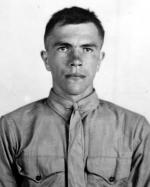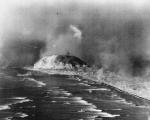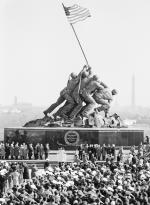![header=[Marker Text] body=[A Marine, he was the oldest and highest ranking of the six men who took part in the famous raising of the U.S. flag on Iwo Jima, Feb. 23, 1945. This scene, photographed by Joe Rosenthal of the Associated Press, was later used in the Marine Corps War Memorial at Arlington. Born Nov. 10, 1919, in Czechoslovakia, Strank grew up in Franklin Borough. Killed in action March 1, 1945, he was reinterred 1949 in Arlington Cemetery.] sign](http://explorepahistory.com/kora/files/1/10/1-A-2E5-139-ExplorePAHistory-a0k4r8-a_450.jpg)
Mouse over for marker text
Name:
Sgt. Michael Strank
Region:
Laurel Highlands/Southern Alleghenies
County:
Cambria
Marker Location:
125 Main Street (PA 271), Franklin Borough
Dedication Date:
May 17, 1986
Behind the Marker
Everyone knows this famous photograph. Taken almost by accident with a 1/400 exposure by Associated Press (AP) photographer Joe Rosenthal, it immortalized five young Marines and a Navy Corpsman, and excited a nation worn down by heavy war losses and anxious to see the brutal war with Japan come to an end.
The six men came from a variety of backgrounds. Harlon Block was a star high-school athlete from Texas. Franklin Sousley was raised on a tobacco farm in Hilltop, Kentucky. Ira Hayes was a Pima Indian. Rene Gagnon was a French-Canadian from New Hampshire whose parents worked in mills. John Bradley, from Wisconsin, had a World War I veteran for a father.
The sixth man, Sergeant Mike Strank, was born in Czechoslovakia in 1919. There, his parents and other relatives lived in a one-room house with a dirt floor. In search of a better life, Strank's father emigrated to America, found a home, and then brought his family over. They settled near Johnstown, Pennsylvania, where the elder Strank worked in a coal mine. A studious kid, Mike Strank played the French horn in school, joined the Civilian Conservation Corps, and in 1939 enlisted in the Marine Corps. By early 1942, he had been promoted to sergeant, and, as part of the 3rd Raider Battalion, participated in landings in the Russell Islands and on Bougainville in 1943-1944.
Civilian Conservation Corps, and in 1939 enlisted in the Marine Corps. By early 1942, he had been promoted to sergeant, and, as part of the 3rd Raider Battalion, participated in landings in the Russell Islands and on Bougainville in 1943-1944.
After the jungle fighting on Bougainville ended, Strank was shipped home on leave, then reported to Camp Pendleton, near San Diego, where he became part of Easy Company, 2nd Battalion, 28th Marines, in the new 5th Marine Division. The USMC was expanding in preparation for the invasion of islands near Japan, where the fighting would be close and bloody. At age twenty-five, Strank was the oldest member of his platoon. Already a combat veteran, he earned the respect of his untested comrades and refused a promotion so that he could remain with the men with whom he trained.
In February 1945, the Marines were ordered to clear the island of Iwo Jima, a scant 600 miles from the Japanese homeland. Only five and a half miles long and two and a half wide, the island was dominated by Mount Suribachi, an extinct volcano whose lava flow made the rest of the small island.
The American high command wanted to use the island as a base for the B-29 bombers that were now hitting Japan; use of Iwo Jima would mean that damaged aircraft and those low on fuel could land here rather than continue on to Guam. But the Japanese knew the Americans were coming. More than 22,000 Japanese soldiers on Iwo Jima had spent months digging an elaborate system of tunnels, pillboxes, and other fortifications. Their commander knew they could not win, but they would kill as many Americans as they could before being wiped out.
Navy and Air Force planes bombed Iwo Jima for more than two months before the American assault, barely scratching the defenders, who, rather than contest the landing, watched as the Marines came ashore on February 19, 1945. Two hours later, the defenders opened up with everything they could bear on the beaches, turning them into a living hell. By the morning of February 21, the 28th Regiment had isolated Suribachi from the rest of the island and was ready to attack. Using flamethrowers, grenades, tanks, and artillery, the Marines literally fought their way up the mountain, yard by yard, sustaining heavy casualties.
On the morning of February 23, the 28th's commander sent a forty-man patrol up to the crest, where the men raised a small American flag before eliminating some remaining Japanese. Down near the base, officers decided that a larger flag could better be seen, so Sergeant Strank and his platoon went up the mountain with it, unrolling telephone wire as they went to connect with the summit. Strank, upon reporting to Sergeant H. "George" Schrier, at the summit, exclaimed, "Colonel Johnson wants this big flag run up high so every son of a bitch on this whole cruddy island can see it!" Strank then ordered Hayes and Sousley to find a pole while he and Block began clearing a space. Hayes and Sousley found a 100-pound length of iron drain pipe, which they dragged over to Strank. The lieutenant decided that Strank's squad would raise the larger flag simultaneously with the lowering of the pole with the first banner on it. The raising of the flag was viewed by Marine captain John Berglund, of Elizabethtown, Pennsylvania, who raised a different kind of flag on a makeshift pole outside his tent.
outside his tent.
The historic moment was almost missed. Having just climbed to the summit, AP photographer Joe Rosenthal was still getting into position as the flags went up and down, but managed to snap a photo. Two other photographers, one with a movie camera, captured the moment when Block leaned into the ground to plant the pole as Strank, Hayes, Block, Gagnon, and Bradley, a Navy Hospital Corpsman with the first patrol, raised the large American flag. Two days later, Rosenthal's photo appeared in newspapers all across nation, igniting a wave of patriotism based on appreciation of the extraordinary sacrifices American soldiers were making in Iwo Jima.
Three of the six men who planted the flag would not survive the fighting. Strank was killed, perhaps by friendly fire, on March 1. Block and Sousley both died later that month, and Bradley was badly wounded. Company E suffered a casualty rate of 84 percent for the battle. More than 26,000 Marines were killed and wounded while securing the island. Strank's spirit lives on, however, together with his buddies, in the mammoth USMC Memorial at Arlington, Virginia: a 110-foot-high memorial that duplicates Rosenthal's famous image.
The six men came from a variety of backgrounds. Harlon Block was a star high-school athlete from Texas. Franklin Sousley was raised on a tobacco farm in Hilltop, Kentucky. Ira Hayes was a Pima Indian. Rene Gagnon was a French-Canadian from New Hampshire whose parents worked in mills. John Bradley, from Wisconsin, had a World War I veteran for a father.
The sixth man, Sergeant Mike Strank, was born in Czechoslovakia in 1919. There, his parents and other relatives lived in a one-room house with a dirt floor. In search of a better life, Strank's father emigrated to America, found a home, and then brought his family over. They settled near Johnstown, Pennsylvania, where the elder Strank worked in a coal mine. A studious kid, Mike Strank played the French horn in school, joined the
After the jungle fighting on Bougainville ended, Strank was shipped home on leave, then reported to Camp Pendleton, near San Diego, where he became part of Easy Company, 2nd Battalion, 28th Marines, in the new 5th Marine Division. The USMC was expanding in preparation for the invasion of islands near Japan, where the fighting would be close and bloody. At age twenty-five, Strank was the oldest member of his platoon. Already a combat veteran, he earned the respect of his untested comrades and refused a promotion so that he could remain with the men with whom he trained.
In February 1945, the Marines were ordered to clear the island of Iwo Jima, a scant 600 miles from the Japanese homeland. Only five and a half miles long and two and a half wide, the island was dominated by Mount Suribachi, an extinct volcano whose lava flow made the rest of the small island.
The American high command wanted to use the island as a base for the B-29 bombers that were now hitting Japan; use of Iwo Jima would mean that damaged aircraft and those low on fuel could land here rather than continue on to Guam. But the Japanese knew the Americans were coming. More than 22,000 Japanese soldiers on Iwo Jima had spent months digging an elaborate system of tunnels, pillboxes, and other fortifications. Their commander knew they could not win, but they would kill as many Americans as they could before being wiped out.
Navy and Air Force planes bombed Iwo Jima for more than two months before the American assault, barely scratching the defenders, who, rather than contest the landing, watched as the Marines came ashore on February 19, 1945. Two hours later, the defenders opened up with everything they could bear on the beaches, turning them into a living hell. By the morning of February 21, the 28th Regiment had isolated Suribachi from the rest of the island and was ready to attack. Using flamethrowers, grenades, tanks, and artillery, the Marines literally fought their way up the mountain, yard by yard, sustaining heavy casualties.
On the morning of February 23, the 28th's commander sent a forty-man patrol up to the crest, where the men raised a small American flag before eliminating some remaining Japanese. Down near the base, officers decided that a larger flag could better be seen, so Sergeant Strank and his platoon went up the mountain with it, unrolling telephone wire as they went to connect with the summit. Strank, upon reporting to Sergeant H. "George" Schrier, at the summit, exclaimed, "Colonel Johnson wants this big flag run up high so every son of a bitch on this whole cruddy island can see it!" Strank then ordered Hayes and Sousley to find a pole while he and Block began clearing a space. Hayes and Sousley found a 100-pound length of iron drain pipe, which they dragged over to Strank. The lieutenant decided that Strank's squad would raise the larger flag simultaneously with the lowering of the pole with the first banner on it. The raising of the flag was viewed by Marine captain John Berglund, of Elizabethtown, Pennsylvania, who raised a different kind of flag on a makeshift pole
The historic moment was almost missed. Having just climbed to the summit, AP photographer Joe Rosenthal was still getting into position as the flags went up and down, but managed to snap a photo. Two other photographers, one with a movie camera, captured the moment when Block leaned into the ground to plant the pole as Strank, Hayes, Block, Gagnon, and Bradley, a Navy Hospital Corpsman with the first patrol, raised the large American flag. Two days later, Rosenthal's photo appeared in newspapers all across nation, igniting a wave of patriotism based on appreciation of the extraordinary sacrifices American soldiers were making in Iwo Jima.
Three of the six men who planted the flag would not survive the fighting. Strank was killed, perhaps by friendly fire, on March 1. Block and Sousley both died later that month, and Bradley was badly wounded. Company E suffered a casualty rate of 84 percent for the battle. More than 26,000 Marines were killed and wounded while securing the island. Strank's spirit lives on, however, together with his buddies, in the mammoth USMC Memorial at Arlington, Virginia: a 110-foot-high memorial that duplicates Rosenthal's famous image.








